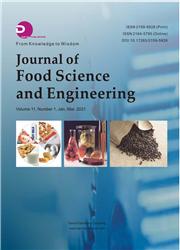Development of Bitter Chocolate Bonbon Stuffed with Almond (Prunus amygdalus var. dulcis) and Its Physicochemical Evaluation and Sensory Acceptance
引用次数: 1
Abstract
Objective: Develop and evaluate bitter chocolate bonbons filled with granulated flour/almond cream, cinnamon powder and decaffeinated coffee essence. Methodology: Two formulations of bitter chocolate bonbons (73% cocoa) stuffed with granulated flour (F1) almond cream (F2), cinnamon powder, and coffee essence were made; no sweeteners. Physicochemical analyses of protein, fat, ash, dry matter, moisture and pH were performed. The nutritional content was estimated according to the regulations. In addition, an evaluation of subjective sensory acceptance was performed with 5-point hedonic scale, with 100 untrained judges who rated the attributes of aroma, texture, taste and color, a descriptive and inferential statistical analysis of the sum of ranges Mann-Whitney (Sigma Stat 4.0). Results: A bonbon with a characteristic chocolate color was obtained as a final product, with a firm texture. The interior obtained a soft beige color with creamy texture and almond pieces. The aroma was chocolate and coffee. The bonbon was characterized by the fat content (67 g) and protein content (21.9 g). Sensory evaluation favored F2 with 89% acceptance, the range of values found for the different attributes of the two formulations was 4 to 4.4, and there was no statistical difference (p > 0.05). Conclusions: We obtained a bitter chocolate bonbon (73% cocoa) without sweetener, it was characterized nutritionally, and both formulations obtained an important acceptance.苦杏仁巧克力糖的研制及其理化评价和感官接受
目的:开发和评价用颗粒状面粉/杏仁霜、肉桂粉和无咖啡因咖啡精华填充的苦巧克力糖果。方法:制作了两种苦巧克力糖果(73%可可)配方,其中填充了颗粒面粉(F1)、杏仁霜(F2)、肉桂粉和咖啡精;没有甜味剂。对蛋白质、脂肪、灰分、干物质、水分和pH值进行了理化分析。营养含量是根据规定估算的。此外,使用5分享乐量表对主观感官接受度进行评估,由100名未经培训的法官对香气、质地、味道和颜色的属性进行评分,对Mann-Whitney(Sigma Stat 4.0)的范围总和进行描述性和推断性统计分析,质地坚硬。内部呈现柔和的米色,带有奶油质地和杏仁片。香气是巧克力和咖啡。通过脂肪含量(67g)和蛋白质含量(21.9g)来表征波旁威士忌。感官评价支持F2,接受率为89%,两种配方的不同属性的值范围为4至4.4,没有统计学差异(p>0.05)。
本文章由计算机程序翻译,如有差异,请以英文原文为准。
求助全文
约1分钟内获得全文
求助全文

 求助内容:
求助内容: 应助结果提醒方式:
应助结果提醒方式:


